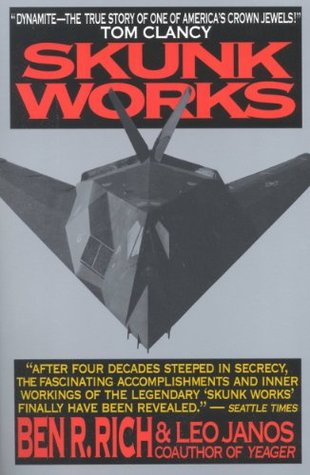More on this book
Community
Kindle Notes & Highlights
by
Ben R. Rich
Read between
August 9 - August 23, 2025
Our engineers were expected on the shop floor the moment their blueprints were approved. Designers lived with their designs through fabrication, assembly, and testing.
Our designers spent at least a third of their day right on the shop floor; at the same time, there were usually two or three shop workers up in the design room conferring on a particular problem.
Bats used a form of sonar to “see” at night, and they were crashing blindly into our low-radar-cross-section tails.
ten basic rules we worked by. A few of them: “There shall be only one object: to get a good airplane built on time.” “Engineers shall always work within a stone’s throw of the airplane being built.” “Any cause for delay shall be immediately reported to C. L. Johnson in writing by the person anticipating the delay.” “Special parts or materials shall be avoided whenever possible. Parts from stock shall be used even at the expense of added weight. Otherwise the chances of delay are too great.” “Everything possible will be done to save time.”
Doolittle put the muscle on Shell to develop a special low-vapor kerosene for high altitudes. The fuel was designated LF-1A. The rumor about the LF abbreviation was that it stood for “lighter fluid.” The stuff smelled like lighter fluid, but a match wouldn’t light it. Actually, it was very similar in chemistry to a popular insecticide and bug spray of that era known as Flit. Once our airplane became operational, Shell diverted tens of thousands of gallons of Flit to make LF-1A in the summer of 1955, triggering a nationwide shortage of bug spray.
Another weird thing was that after a flight the windshields often were pitted with tiny black dots, like burn specks. We couldn’t figure out what in hell it was. We had the specks lab tested, and they turned out to be organic material—insects that had been injected into the stratosphere and were circling in orbit around the earth with dust and debris at seventy-five thousand feet in the jet stream. How in hell did they get lifted up there? We finally figured it out: they were hoisted aloft from the atomic test explosions in Russia and China.
The Blackbirds flew 3,500 operational sorties over Vietnam and other hostile countries, had more than one hundred SAM SA-2 missiles fired at them over the years, and retired gracefully in 1990 after twenty-four years of service as the only military airplane never to be shot down or lose a single crewman to enemy fire. Which was truly amazing because the Blackbird and its crews continuously drew the most dangerous missions.
There are very few strong-willed individualists in the top echelons of big business—executives willing or able to decree the start of a new product line by sheer force of personal conviction, or willing to risk investment in unproven technologies. As salaries climb into the realm of eight-figure annual paychecks for CEOs, and company presidents enjoy stock options worth tens of millions, there is simply too much at stake for any executive turtle to stick his neck out of the shell. Very, very few in aerospace or any other industry are concerned about the future beyond the next quarterly
...more
I worry about our shrinking industrial base and the loss of a highly skilled workforce that has kept America the unchallenged aerospace leader since World War II. By layoffs and attrition we are losing skilled toolmakers and welders, machinists and designers, wind tunnel model makers and die makers too. And we are also losing the so-called second tier—the mom-and-pop shops of subcontractors who supplied the nuts and bolts of the industry, from flight controls to landing gears. The old guard is retiring or being let go, while the younger generation of new workers lucky enough to hold aerospace
...more


